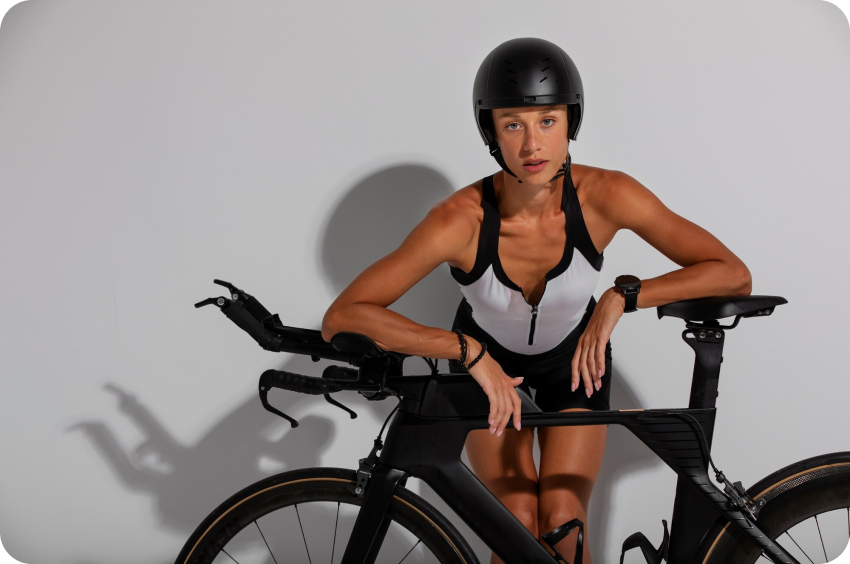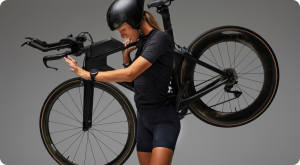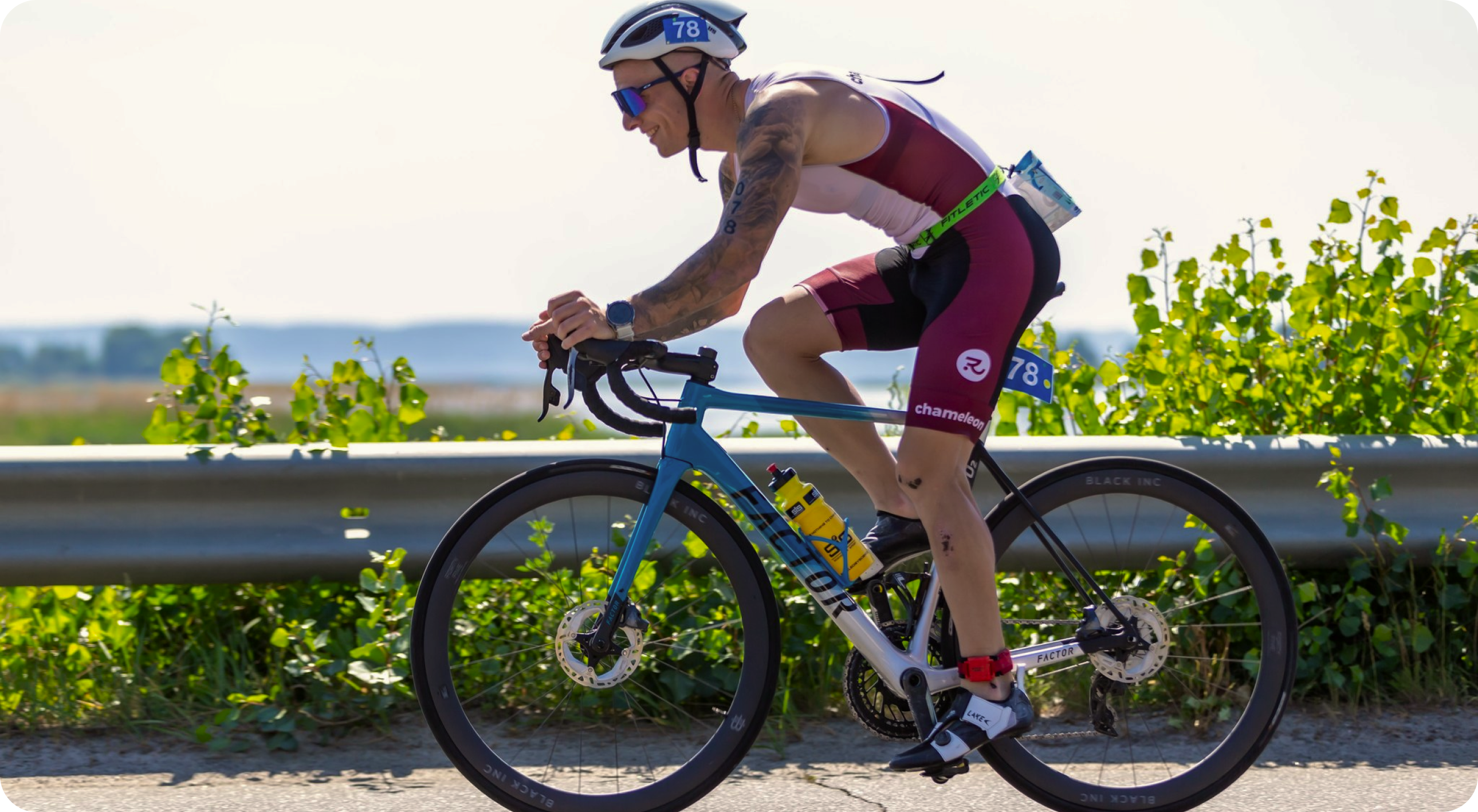As you know, triathlon consists of three disciplines: swimming, cycling, and running.
While each discipline requires specific skills and training, the bike leg is often the longest and most demanding in terms of equipment choice.
Therefore, investing in the right triathlon bike can make a significant difference in an athlete’s overall performance.
In a comprehensive review of triathlon bikes, various factors should be considered, including frame materials, geometry, componentry, and budget.
Athletes of all levels should carefully evaluate their needs, preferences, and racing goals when selecting their next two-wheeled companion.
Whether aiming for podium finishes or personal bests, choosing the right bike is a critical step towards success in the world of triathlon.
Why a Proper Triathlon Bike is Important?
Choosing the right bike for a triathlon is crucial because it directly affects an athlete’s performance and overall experience in the sport. Let’s break down why it’s so important.
Aerodynamics
Tri bikes are designed to be aerodynamic, reducing wind resistance and allowing athletes to maintain higher speeds with less effort.
This is especially important in longer triathlons, where every bit of energy conservation matters.
Comfort
Endurance is key in a triathlon, and riding position comfort plays a big role in maintaining it.
A bike that fits well and is ergonomically designed can prevent discomfort and fatigue during the cycling leg, leaving athletes fresher for the subsequent stages.
Speed
A well-chosen race bike can help athletes achieve faster bike split times, giving them an advantage over competitors.
This is achieved through various design features such as aero frames, deep-section wheels, and integrated components that minimize drag and maximize efficiency.
Efficiency
Efficiency is about getting the most out of every pedal stroke.
Triathlon bikes often come with specialized gearing and components optimized for the demands of the sport.
This ensures that athletes can sustain high speeds with less effort, saving energy for the run portion of the race.

Factors to Consider When Choosing a Triathlon Bike
Choosing a triathlon road bike requires a keen understanding of several important factors that will have a significant impact on your cycling experience.
Key factors include frame materials and construction, bike geometry, drivetrain components, wheel and tire selection, and budgetary constraints.
In the following sections, we’ll take a closer look at these elements to give you a complete picture of the complex world of road bike triathlon.
Frame Materials and Construction
When it comes to the materials used in the triathlon bike frame, three main options dominate the market: carbon, aluminum, and titanium.
Carbon frames are popular because of their exceptional strength-to-weight ratio.
They provide excellent stiffness and responsiveness without sacrificing weight.
However, they can be relatively expensive and not always available in your local bike shop.
Aluminum frames, on the other hand, are cost-effective and offer good stiffness, making them suitable for beginners or people on a budget.
Titanium frames strike a balance between carbon and aluminum, offering durability, comfort, and a smooth ride, although they are more expensive.
Construction of the Frame
Aerodynamic frame design is a key aspect of bikes for triathletes.
An aerodynamic frame can significantly reduce aerodynamic drag, increasing speed and efficiency while cycling.
Elements such as wind tunnels, integrated disc brakes, and streamlined shapes are designed to minimize air resistance.
Road bikes for triathlons often have unique designs.
These include deep-section aero wheels and integrated handlebars to further improve aerodynamic performance.

Bicycle Geometry
Bike geometry has a significant impact on both comfort and performance.
A triathlon road bike typically has a more aggressive and aerodynamic geometry than traditional road bikes.
The geometry is designed to place the rider in a more aerodynamic position.
This reduces wind resistance and increases speed.
However, this design can sacrifice some comfort, especially on long rides.
The geometry emphasizes stability and ease of handling, making it suitable for long rides over a variety of terrain.
Groupset and Drivetrain
A high-quality drivetrain is essential for optimal triathlon performance.
It includes components such as derailleurs, cranksets, cranks, cassettes, and brake levers.
These components must function smoothly and efficiently to ensure smooth shifting and reliable braking during the race.
Investing in a reputable brand and quality drivetrain can greatly improve your overall cycling experience and race performance.
Examples
Shimano, SRAM, and Campagnolo are the leading manufacturers of drivetrains.
Shimano is known for its precision, durability, and wide range of offerings for different budgets.
SRAM emphasizes innovation and weight reduction, which attracts cyclists looking for the most advanced technology.
Campagnolo is known for its exceptional craftsmanship and smooth shifting, which often attracts avid cyclists who appreciate traditional engineering.
Wheels and Tires
Tri bike wheels play a crucial role in triathlon, significantly affecting speed and aerodynamics.
However, they can be heavier and affect handling, especially in strong headwinds.
The right wheel choice depends on the specific race course, your cycling skills, and your ability to handle different wheel depths.
The choice of tires is equally important.
Clinker tires, the most common choice, offer convenience and ease of repair.
Tubular tires are lighter and offer a smoother ride but can be difficult to repair.
Tubeless tires are becoming increasingly popular due to their puncture resistance and lower rolling resistance.
Choosing the right type of tire involves taking into account factors such as racing conditions, terrain, and personal preferences.

Budget Considerations
Setting a budget for your bike for triathletes is an important first step.
Tri bikes can range in price from a few hundred dollars to several thousand dollars.
It is important to assess your financial capabilities and allocate funds accordingly.
Consider factors such as the quality of the bike, brand reputation, and purpose.
This will help you set a reasonable budget that meets your overall triathlon goals.
The relationship between price and quality of a bike is a balance.
While expensive bikes often boast advanced features, lighter frames, and higher-quality components.
Mid-range bikes can provide exceptional performance without breaking the bank.
Evaluate the value of each bike within your budget and prioritize the features that will most contribute to your performance and comfort during triathlon racing.
If you are not going to buy a brand-new bike, consider exploring our triathlon gear marketplace.
Here, you will find everything you need for your training and races: from entry-level triathlon bike to swimming gear, and everything in between.
In the following sections, we’ll look at specific road bikes for triathlon models based on these critical factors to meet the needs of athletes of varying skill levels.
Top 5 Tri Bike Models for Triathletes
Let’s explore the key triathlon bike brands – from entry-level to advanced models.
Entry-Level Triathlon Bikes
For beginners venturing into the world of triathlons, selecting the right entry-level bike is essential.
Several specific types of triathlon bikes cater to this demographic, offering affordability and performance suitable for newcomers.
Among these models, the Trek Domane AL 2 stands out for its accessible price point and durable aluminum frame.
It’s an excellent choice for those looking to explore triathlons without a substantial financial commitment.
On the downside, the Domane AL 2 may lack some of the advanced features found in pricier models.
Another entry-level option is the Giant Contend AR 2, known for its versatility and comfortable geometry.
It strikes a balance between road and triathlon design, making it ideal for beginners looking to explore various cycling disciplines.
However, it might not offer the same level of aerodynamics as specialized triathlon bikes.
Intermediate-Level Triathlon Bikes
Triathletes looking to improve their performance and invest in a more advanced triathlon bike have several attractive options.
The Cervélo P series is a great choice.
This time trial bike is known for its exceptional aerodynamics and speed.
Its carbon frame and integrated components provide a higher level of performance than entry-level bikes.
However, the price may scare off those on a tight budget.
The Specialized Shiv Expert is another mid-level gem that is praised for its aerodynamic excellence and comfortable fit.
It strikes a balance between speed and comfort.
This makes it a great choice for riders looking to upgrade from entry-level bikes. However, some may find it too expensive.
Advanced Triathlon Bikes
For advanced triathletes looking for maximum performance, the Canyon Speedmax CF SLX is the best bike choice.
This road bike for triathlon boasts an aerodynamically optimized frame, integrated storage solutions, and precision engineering.
This makes it a formidable weapon for competitive triathletes.
However, its price reflects its elite status.
The BMC Timemachine 01 is another advanced-level option with exceptional aerodynamics and an emphasis on integration.
It offers the most advanced technology and materials to ensure outstanding performance.
The investment required for a triathlon road bike of this caliber is significant.
But for those looking to finish on the podium, they can be well worth it.
Women’s Triathlon Bikes
Women triathletes have unique requirements for bike fit and design.
Liv Avow Advanced Pro 1 is a women’s road triathlon bike known for its special geometry and high-performance components.
It meets the specific needs of female athletes by offering a proper bike fit and performance.
However, it can be relatively expensive.
The Trek Speed Concept Women’s series is another noteworthy option that features a different frame design and components.
It aims to optimize aerodynamics and comfort for female athletes.
Although it provides an excellent fit, potential buyers should be prepared for a premium price.

Customized Triathlon Bikes for Professional Cyclists
Customized triathlon bikes, such as the Felt IA Advanced Disc, allow athletes to customize their bikes to their exact requirements.
This level of customization can significantly increase comfort and performance.
Buyers can choose frame sizes, components, and accessories according to their preferences and body size.
However, this level of personalization often comes at a higher price.
Another example is the Cervélo P-Series Custom, which allows triathletes to choose their components and fine-tune the geometry of the bike.
This level of customization ensures that the bike is perfectly matched to the rider’s needs and preferences.
This makes it the perfect choice for serious athletes who are willing to invest in their gear.
In the following sections, we will complete our review of the best triathlon bikes with a detailed analysis of the advantages and disadvantages.
This will allow athletes to make an informed decision based on their skill level and individual requirements.
Conclusion: What Kind of Bike for Triathlon to Choose?
So, choosing the right type of bike for a triathlon is a key decision.
It can have a significant impact on your performance and enjoyment of the event.
In this article, we’ve taken a look at the key factors to consider when choosing a triathlon bike.
From frame materials to group sets, wheels, and budget considerations.
We also highlighted specific models for different skill levels and unique needs.
The importance of choosing the right bike cannot be overstated.
It directly affects your speed, comfort, and overall racing experience.
Choosing a triathlon road bike that matches your triathlon goals is paramount.
Whether you’re a beginner, intermediate, or seasoned pro, choosing the right bike for you is crucial.
The right bike can improve your performance and give you the competitive edge you need to succeed in the sport.
Before you start choosing a triathlon bike, we recommend that you do thorough research and, if possible, test-drive the bikes you are considering.
Taking the time to research your options and physically test-drive different models will help you make an informed decision that meets your specific needs.

Frequently Asked Questions
What are the key factors to consider when choosing a triathlon bike?
When choosing a triathlon bike, it’s essential to consider factors such as aerodynamics, comfort, fit, efficiency, and budget.
Aerodynamics plays a crucial role in reducing drag and maximizing speed, while comfort and fit ensure that the bike is suitable for long-distance racing.
Efficiency involves selecting components and gearing optimized for the demands of triathlon while staying within your budget to ensure you get the best value for your investment.
How does a triathlon bike differ from a normal road bike?
Triathlon bikes are designed specifically for the demands of triathlon racing, with a focus on aerodynamics and integration.
They typically have a more aggressive geometry, with steeper seat tube angles and elongated top tubes to promote a forward, aerodynamic position.
Additionally, time trial bikes often feature integrated storage solutions, aerodynamic frames, and specialized components geared towards maximizing speed and efficiency.
Can I use a road bike for a triathlon instead of a triathlon-specific TT bike?
While it’s possible to use a road bike for a triathlon, triathlon-specific bikes offer several advantages, particularly in longer-distance races.
Triathlon bikes are optimized for aerodynamics, comfort, and efficiency, which can lead to faster bike split times and better overall performance.
However, if you already have a road bike and it fits you well, it can still be a suitable option for shorter or less competitive races.
How important is a bike fit for triathlon racing?
Bike fit is crucial for triathlon racing, as it directly affects comfort, efficiency, and performance.
A properly fitted bike can prevent discomfort and injuries during the race, while also optimizing power output and aerodynamics.
Professional bike fitting services can help ensure that your bike is adjusted to your unique biomechanics and racing goals, maximizing your chances of success on race day.
What are some tips for maintaining a triathlon bike?
To maintain and optimize your triathlon bike, regular maintenance is essential.
Keep your bike clean, lubricate the chain, and make sure all components are in good working order.
Consider investing in professional road bike tuning services.
This way, you can achieve a perfect fit and reduce the risk of discomfort and injury during racing.
Additionally, schedule regular tune-ups with a qualified bike mechanic to address any issues and keep your bike performing at its best.





